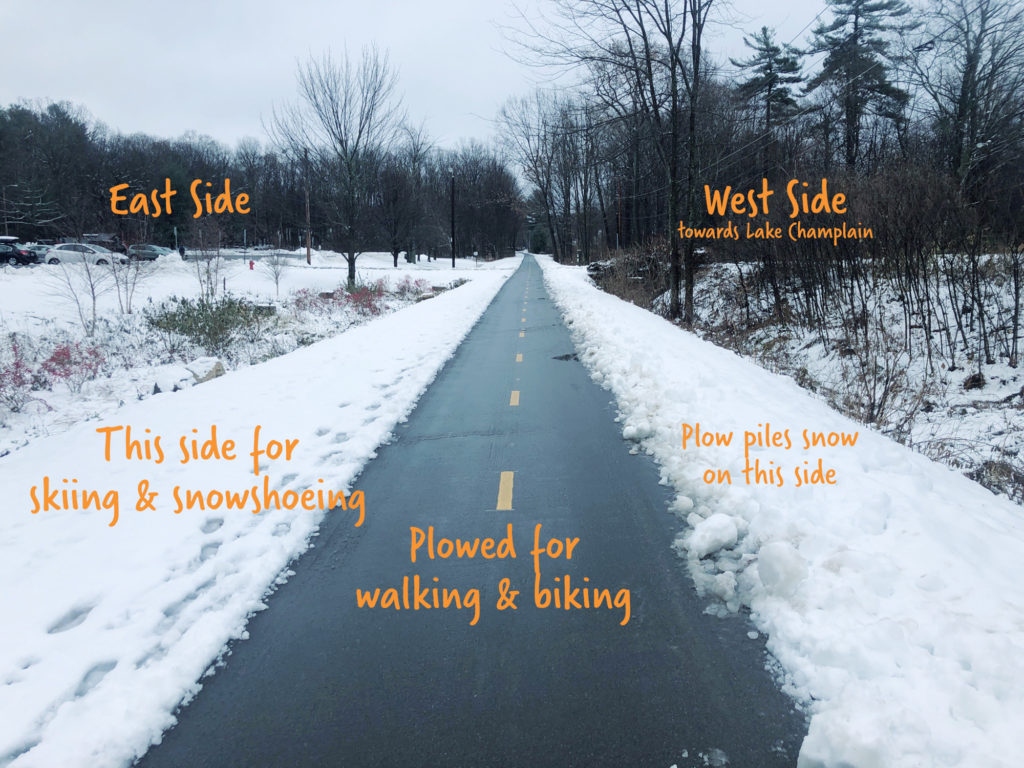Recreation Paths: Winter Plowing Policy

Winter Greenway plowing policy
Depending upon the event and type of snow, intersection clearing and plowing could begin anywhere between 24 to 72 hours after a storm event. During and immediately after snow storms our team focuses their attention on making sure all of our public facilities (City Hall, Library, Miller Community Center, Leddy Ice Arena, etc.) are able to open safely and as scheduled, before moving to the recreation paths.
Salt and sand is not typically used, and any application of salt and sand will be carefully considered (recognizing the harmful impact they have on lake health). Therefore, we highly recommend shoes and bikes designed to handle icy conditions on the paths! Even after the path is plowed, snow blows over, or snow melts and refreezes, and things can get slippery.
In order to support multi-use recreation on the path, as much as possible we plow at the minimum width along the path corridor and push the snow to the western side of the path. This method leaves ample snow on the sides, and tracks for cross country skiing usually form nicely. We will plow or snowblow the entire length of the path from North Ave Extension through Oakledge Park.
Here’s how our plowing plan leaves room for skiing along the east side of the path.

If you’re hoping for fresh snow for skiing, better hit the path early.
Also note that the 127 Bike path is not plowed, but the paved section in Ethan Allen Park from the parking lot to the access trail for the tower are cleared for people to walk.
FAQ’s
How does the Bike Path differ from other areas in our system?
The Bike Path is integrated in the entirety of the trail systems in Burlington and is maintained not only as a transportation corridor but also for recreation. The Department is seeking to maximize the recreational potential of the bike path while supporting transportation. In some cases, waiting to plow or service the bike path, maximizes the recreational uses of the path in a way that we want to support. However, the conditions during a snow event or the actual consistency of the snow/ice also determines the timing of maintenance, as an example, if Burlington receives sleet or freezing rain then snow, it makes sense to service the path sooner versus later based on what will happen. Decision making around the timing of path plowing is a group discussion that involves, at minimum a review with supervisors and other team members.
How quickly with the path get cleared after a snow event?
Depending upon the event and type of snow, bike path intersection clearing and bike path plowing could begin anywhere between 24 to 72 hours after a storm event. During and immediately after snow focus of Department snow clearing should be making sure all primary locations (City Hall, Library, Miller Community Center, City Hall/BCA, Police, Leddy Ice Arena, etc.) are able to open safely and as scheduled, before moving to recreation paths.
Is Salt or Sand Treatment Used?
Salt and sand can only be used with the approval of supervisor for health and safety concerns on the path. The lake cannot support consistent salting and sanding of the path, due to the run off and likelihood of it depositing directly into the Lake, contributing to beach closures in the summer season. We highly recommend traction devices for walking and running.
Why are the bridges not plowed?
Many pedestrian bridges cannot support the full weight of a traditional truck and plow, nor were they built to be plowed as they lack supports and guides to protect the bridge from the damaging impacts of plow blades.
Are there any exceptions to this policy?
Yes, they are as follows:
- Areas where snowbanks have been pushed to the east or west for large snow drifts that the truck cannot plow through.
- If we are trying to get water cleared off the path and into drainage structures set to the east and west sides. Snow obstructs proper drainage that the path was designed for and must be cleared to avoid deep puddles of water from freezing onto the bike path causing unsafe and slippery conditions for path users.
- When the tree crew, water department, BED, and other stakeholders are working on the path, the full width of path needs clearing.
- Detours for construction can obstruct clearing snow.
